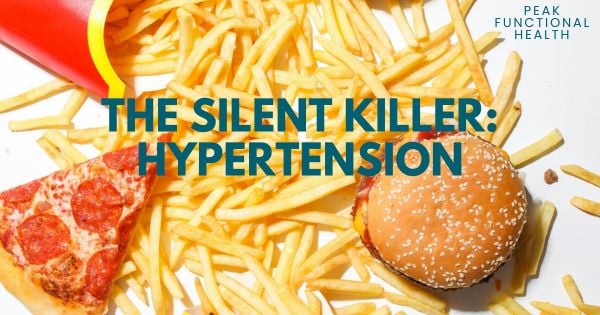Hypertension’s Connection to Metabolic Disease

Known as the silent killer, the Center for Disease Control estimates that nearly one half of adults have high blood pressure (HBP), and in 2023 it was a primary contributing cause of more than 664,000 deaths in the United States alone. Of those with a hypertension diagnosis, only one in four have their pressure “under control.”
HBP causes damage to the blood vessels and increases the risk of both stroke and heart disease, yet when most people hear “high blood pressure,” they think of it as a stand-alone problem. Impossible in many cases to sense internally, HBP is stealthy as it sneaks up with age. Hypertension often travels not far from prediabetes or type 2 diabetes, and the overlap is not coincidence, it comes from shared roots in metabolic dysfunction.
What High Blood Pressure Really Means
Hypertension is simply the measurement of how much force your blood exerts against artery walls as it circulates. The systolic pressure (top number) is the force during contractions of the heart while diastolic pressure (bottom number) is the arterial pressure between contractions. When pressure is consistently high, the heart and vessels are under strain, raising the risk of heart disease, stroke, kidney failure, and cognitive decline.
Elevated blood pressure doesn’t usually appear out of nowhere but rather it’s the body showing signs of distress due to underlying imbalances in the body. In that way, it is less a stand-alone diagnosis and more an early indicator of metabolic stress.
The Mechanics of Hypertension
Blood pressure can be influenced by genetic factors but is tightly regulated by several systems in the body:
Kidneys: The kidneys release hormones that adjust sodium, potassium, and water balance to keep blood pressure stable. Dysfunction here can mean fluid retention and higher pressure.
Arteries: Healthy arteries are flexible, expanding and contracting with each heartbeat. Inflammation, plaque buildup, and oxidative stress stiffen artery walls, raising pressure.
Hormones: Cortisol (stress), aldosterone (salt and water balance), and insulin all play direct roles in how pressure is managed. Chronically high insulin, a hallmark of insulin resistance, directly increases blood pressure by telling the kidneys to retain sodium and by thickening arterial walls.
Hypertension, then, is more than “too much salt” or “bad luck.” It’s a sign of deeper systemic issues that overlap closely with metabolic dysfunction.
The Mechanics of Type 2 Diabetes
Type 2 diabetes develops gradually, starting with insulin resistance. In this state, the body produces more and more insulin to keep blood sugar stable, but over time, cells stop responding effectively. This typically presents as hyperinsulinemia (chronically high insulin) and eventually rising blood glucose.
This high-insulin state does more than affect blood sugar. It promotes fat storage, fuels inflammation, and thickens arterial walls. It also drives the kidneys to hold onto sodium and water, directly increasing blood pressure. That’s why many people experience high blood pressure years before they’re officially diagnosed with type 2 diabetes, the dysfunction has already begun.
The Shared Roots of Hypertension and Diabetes
When viewed together, hypertension and diabetes look less like separate diseases and more like two branches of the same tree. The roots include:
Insulin resistance and hyperinsulinemia (driving both high blood sugar and higher blood pressure).
Inflammation and oxidative stress (damaging arteries, disrupting hormones, and fueling metabolic dysfunction).
Dietary imbalance (excess refined sugar, processed foods, poor-quality fats, low fiber, and low potassium intake).
Lifestyle load (chronic stress, poor sleep, sedentary habits, excess alcohol or smoking).
These overlapping drivers explain why people with high blood pressure often go on to develop diabetes, and why those with diabetes can also struggle with hypertension.
Why This Connection Matters
Seeing the link between these conditions changes how we think about them. Rather than treating high blood pressure as an isolated number to medicate, we can recognize it as an early warning sign of broader metabolic dysfunction. That means there’s an opportunity to intervene earlier, before more serious disease develops.
The encouraging part is that the same overarching lifestyle factors that improve blood sugar also improve blood pressure: eating fewer processed foods and added sugars, increasing whole and nutrient-dense foods, supporting electrolyte balance (especially potassium), moving regularly, managing stress, and getting restorative sleep.
In short, high blood pressure and type 2 diabetes share common roots, and so does the path toward healing. When we support the body’s underlying systems, we’re not just lowering a number on a chart, we’re rebuilding the terrain for long-term health.